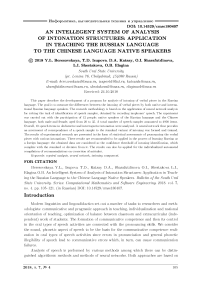An intelligent system of analysis of intonation structures: application in teaching the Russian language to the Chinese language native speakers
Автор: Beresovskaya Y.L., Isupova T.D., Katsay D.A., Sharafutdinova O.I., Shestakova L.I., Elagina O.B.
Рубрика: Информатика, вычислительная техника и управление
Статья в выпуске: 4 т.7, 2018 года.
Бесплатный доступ
This paper describes the development of a program for analysis of intoning of verbal pieces in the Russian language. The goal is to measure the differences between the intoning of verbal pieces by both native and international Russian language speakers. The research methodology is based on the application of neural network analysis for solving the task of identification of speech samples, obtained by recording inophones’ speech. The experiment was carried out with the participation of 12 people: native speakers of the Russian language and the Chinese language, both male and female, aged from 20 to 35. A total number of speech samples amounted to 4800 items. Overall, 10 speech items in declarative and interrogative intonation were analyzed. A neural network that provides an assessment of correspondence of a speech sample to the standard variant of intoning was formed and trained. The results of experimental research are presented in the form of statistical assessments of pronouncing the verbal pieces with various intonations. These results are recommended to be applied in the process of learning Russian as a foreign language: the obtained data are considered as the confidence threshold of intoning identification, which complies with the standard or deviates from it. The results can also be applied for the individualized automated compilation of recommendations on correction of mistakes.
Cepstral analysis, neural network, intoning component
Короткий адрес: https://sciup.org/147233181
IDR: 147233181 | УДК: 004.934, | DOI: 10.14529/cmse180407
Список литературы An intelligent system of analysis of intonation structures: application in teaching the Russian language to the Chinese language native speakers
- Drugman T., Bozkurt B., Dutoit T. Complex Cepstrum-based Decomposition of Speech for Glottal Source Estimation // INTERSPEECH, 10th Annual Conference of the International Speech Communication Association, (Brighton, United Kingdom, September 6- 10). ISCA, 2009. P. 116-119.
- Katsay D., Doronina E., Kazakova Y., Kharchenko E., Isupova T. Analysis of Speech Samples as a Means of Intensification of Teaching Phonetics of a Foreign Language // ICERI2017 Proceedings: 10th International Conference of Education, Research and Innovation (Seville, Spain, November 16-18). IATED, 2017. P. 2771-2778. DOI: 10.21125/iceri.2017.0789
- Бодуэн де Куртене И.А. Избранный труды по общему языкознанию. М.: Издательство Академии наук СССР, 1963. 391 с.
- de Saussure F. Cours de Linguistique Generale. Paris, Albert Sechehaye et Albert Riedlinger, Payot, 1971. 318 p.
- Богородицкий В.А. Курс экспериментальной фонетики применительно к литературному русскому произношению. Казань: Тип. Имп. ун-та, 1917. 74 с.
- Рогозная Н.Н. Проект автоматизированного обучения фонологии неродного языка // Вестник Бурятского государственного университета. 2017. №3. С. 87-94.
- Бондарко Л.В. Фонетика современного русского языка. СПб.: Издательство СПбГУ, 1998. 276 с.
- Брызгунова Е.А. Практическая фонетика и интонация русского языка. М.: Издательство МГУ, 1963. 308 с.
- Артемов В.А. Об интонеме и интонационном варианте // Интонация и звуковой состав: сборник научных трудов. М.: Издательство МГУ, 1965. С. 3-20.
- Брызгунова Е.А. Интонация // Русская грамматика. Ч. 1. М.: Наука, 1980. С. 96-122.
- Рогозная Н.Н. Влияние сингармонизма на формирование фонологического уровня А 2 // Вестник Бурятского государственного университета. 2010. №10. С. 74-79.
- Bondarko L.V., Volskaya N.B., Tananaiko S.O., Vasilieva L.A. Phonetic Properties of Russian Spontaneous Speech // 15 ICPhS Barselona. 2003. P. 2973-2976. URL: https://pdfs.semanticscholar.org/6b1b/c7e6d5abcea5b5c7a50bf923b8d2c339bda2.pdf (дата обращения: 10.08.2018).
- Рогозная Н.Н. Билингвизм. Интерязык. Интерференция. Иркутск: Издательство ИрГУ, 2012. 171 с.
- Shafiro V., Kharkhurin A.V. The Role of Native-Language Phonology in the Auditory Word Identification and Visual Word Recognition of Russian-English Bilinguals // Journal of Psycholinguistic Research. 2009. Vol. 38, No. 2. P. 93-110.
- DOI: 10.1007/s10936-008-9086-y
- Best C.T. A Direct-Realist View of Cross-Language Speech Perception // Speech Perception and Linguistic Experience / W. Strange (еd.). York Click, 1995. P. 171-204.
- Wade-Woolley L. First Language Influences on Second Language Word Reading: All Roads Lead to Rome // Language Learning. 1999. Vol. 49, No.3. P. 447-471.
- DOI: 10.1111/0023-8333.00096
- Панова Р.С. Фонетическая интерференция в русской речи китайцев // Вестник Челябинского государственного университета. Филология. Искусствоведение. 2009. № 22. С. 231-233.
- Чжэ Ч. Звуковая интерференция в русском языке под влиянием родного языка в условиях русско-китайских языковых контактов // Филологические науки. Вопросы теории и практики. 2016. № 3. С. 179-184.
- Трубчанинова И.И. Лингводидактические основы обучения интонации русского языка в условиях учебного трилингвизма. Владикавказ, 2012. 194 с.
- Мазина Л.З. Методика обучения студентов-иностранцев интонации русского языка (начальный этап контакта испанского языка с русским. М., 1984. 257 с.
- Румянцев М. Синтез китайских тонов // Вопросы лингвистики. 1988. № 1. С. 82-93.
- Сорокоумова Д., Корелин О., Сорокоумов А. Построение и обучение нейронной сети для решения задачи распознавания речи // Transactions of NNSTU.2015. № 3 (110). С. 77-84.
- Румянцева Н.М., Гарцова Д.А., Кужаков В.Е. Электронные средства обучения как эффективный инструмент интенсификации процесса обучения китайских учащихся русской фонетике (этнометодический аспект) // Scientific Research - 2016: Proceedings of Articles the International Scientific Conference (Chezh Republic, Karlovy Vary-Russia, 29-30 September 2016). Киров, 2016. С. 175-183.
- Gabdrahmanova P.L., Bogatova E.N., Mustafina L.R. Development of Communicative Competence in the Online Learning Environment of Russian as a Foreign Language: Opportunities and Prospects // Educational Technologies and Society. 2017. № 2. С 329-345.


